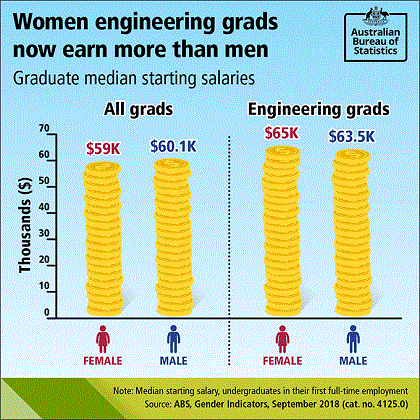A new report from the Australian Bureau of Statistics (ABS) shows female engineering graduates earned slightly more than their male counterparts for the first time in 2017.
These figures account for males and females who have completed an undergraduate engineering degree and have started in their first full-time role. According to the report, the median starting salary for female engineering graduates is $65k. For male engineering graduates, the median starting salary is $63.5k.
 Source: Australian Bureau of Statistics
Source: Australian Bureau of Statistics
According to the ABS, female graduates still earn less than male graduates in 15 out of the 19 key industries but are on a par in the communications field.
These figures come from the Australian Graduate Outcomes Survey 2017, which was conducted by the Quality Indicators for Learning and Teaching (QILT) and released in February this year. They aim to provide students with relevant and transparent information about Australian higher education institutions from the perspective of recent students and graduates. The report is an aggregation of the experiences of recent graduates from 97 higher education institutions across the country.
The report also suggests the gender pay gap is closing. In 2016, the median full-time salary for female graduates was $3600 less than it was for male graduates across all study areas. In 2017, the difference in median wages fell to $1100.
HR director at engineers AECOM Helen Fraser told the Australian Financial Review back in February that the figures weren’t surprising.
“There is a shortage of technical talent for engineers. We are all fighting for the same group of people,” Ms Fraser said.
Currently, women account for less than 20 per cent of engineering graduates. With companies now having to report on gender-balance, they need to try harder to attract women.
“It’s not the requirement to report, it’s the desire to attract the talent. Because there is a shortage. There are more grads who have had multiple job offers – they have a choice,” said Ms Fraser.
The national president of Engineers Australia Trish White told Yahoo Finance that this is a reflection of the growing need for female graduates in the industry.
“The problem-solving of modern engineering is very human-centric, and so employers are looking to diversify their workforce, keen to recruit creative and communications skills as well as the technical,” she said.
“The difficulty is that only 13 per cent of working engineers in Australia are women, and the more experienced they are, the harder they are to find. So much so that we know of engineering companies that pay their staff ‘finders fees’ to bring in experienced women engineers for recruitment.
“It’s a great time for females to contemplate a career in engineering.”
While this is good news for new graduates, a joint report from the Bankwest Curtin Economics Centre and the Workplace Gender Equality Agency in 2016 demonstrated that the wage gap widens as time goes on, often because women take on family roles.
ABS Program Manager Dean Bowley said that young women are continuing to achieve higher levels of education than young men. The latest figures showed 45 per cent of women had completed a bachelor’s degree or higher before the age of 30, compared with 32 per cent of men.
“Despite this progress, there are still plenty of challenges,” he said.
“The gender pay gap has remained stable over the last decade, with women earning 89 per cent of the earnings of men, taking into account the differences in working hours. Superannuation balances for women approaching retirement are 37 per cent lower than men.”
The situation becomes more concerning at a postgraduate coursework level, where the median salary for female engineers is $15,000 less than it is for males. This was an increase from 2016 when the gap was $14,300. At a postgraduate research level, males typically out-earned females by $3000 in 2016 and $4500 in 2017.
According to Ms White, one of the reasons for this is the poor retention of women in engineering and a lack of female role models.
“Unfortunately women engineers are leaving the profession at greater rates than their male counterparts … It does mean there is a lack of female role models at higher levels. It’s hard to imagine yourself in a senior role if there isn’t anyone there that looks like you. I think that plays into promotion and pay rise negotiations as well,” she said.
“It’s not all a bad story, though, because some talented women engineers are being enticed by high salaries in banking and finance, which goes to show how transferable the skills of engineers are.”


